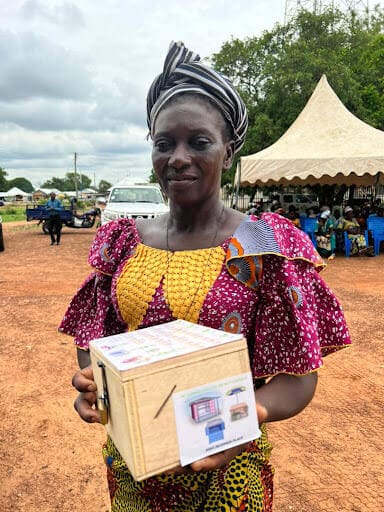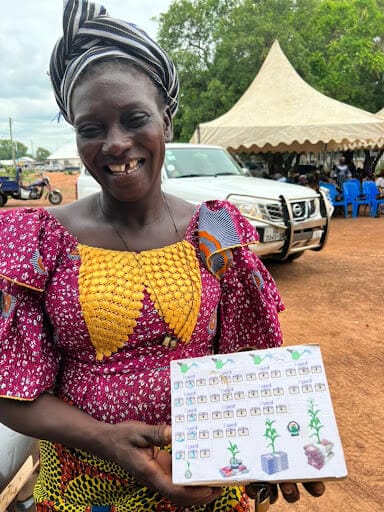

Pictures of a cash transfer recipient with her savings box
In many parts of the Global South, millions of individuals face the harsh realities of extreme poverty each day. They carry the heavy burden of not having enough resources to meet their needs, and this constant struggle takes a toll on their mental bandwidth. It makes it tougher to make important decisions and shape their futures. Promising evidence from several years of work, including by our Global Development team, shows that cash transfer programs can ease some of this cognitive burden. By providing recipients with cash, they create cognitive slack, helping to mitigate some of the pressures of chronic cognitive scarcity and enabling individuals to make choices that align with their own intentions and in the service of improving their own well-being and future. When cash transfer programs are thoughtfully designed with additional supports to tackle the behavioral constraints and biases that influence decision-making, their impact goes beyond alleviating some of the immediate effects of scarcity. This approach guides recipients in making the most effective use of the funds, increasing the likelihood of achieving positive long-term results.
In a recent randomized control trial (RCT) in Ghana, we were able to implement and test several behaviorally informed designs (in partnership with the World Bank Social Protection and Jobs team in Ghana and the Government of Ghana),within a productive inclusion program Complementary Livelihoods and Asset Support Scheme (CLASS), that provides cash transfers and additional support, such as training and mentorship, to households experiencing extreme poverty. In addition to the promising evidence from our quantitative analysis, we conducted qualitative research to uncover the experiences of cash transfer recipients, and gain deeper insights on the impact of our solutions. Our intervention included two main components:
- Tools such as a box for storing savings, and goal-setting and plan-making activities to help recipients save for productive investments
- Business-planning tools, including a business growth activities tracker with a soft commitment component, to enable cash recipients to grow their businesses
Our solutions had a positive and significant effect on recipient savings behaviors such as setting a clear savings goal, developing a plan to achieve it, and actually setting aside money to save, but the impact did not extend to improved business practices.
What we were not able to ascertain from the RCT results was how and why the solutions worked in the way they did.
Beyond numbers: uncovering human stories through qualitative research
To understand both the how and why a bit more deeply, we also conducted qualitative interviews with a subset of cash transfer recipients. Through these interviews we sought participants’ perspectives and experiences with our solution designs to try to tease out any underlying factors that influenced their interactions with the designs and, ultimately, lead to mechanisms for effective behavior change.
By talking directly to recipients, we were able to uncover the reasons the savings component of our designs had such a significant impact: the savings box we provided helped keep the act of saving top-of-mind. This box was thoughtfully labeled with the specific productive goal chosen by the cash transfer recipients, creating a meaningful reminder of the exact purpose they were saving towards and providing a tangible connection to the concrete goal they were striving to achieve. Additionally, we designed stickers for recipients to place on their savings boxes whenever they contributed to their savings, helping them easily track their progress in saving toward their productive goal.
As one recipient told us, “I used to sell and bring the money home, keep it in the house and send anybody to go and take money for every little expense but after the training, I realized that what I did was a big mistake because that money could have been saved to improve my business”. Another recipient captured the essence of savings in just a few words, “they (trainers) showed us a picture and a man planted a maize and watering it. As it is watered, it grows and is the same way, when you save and set a goal, you will be able to achieve it”.
The recipients we interviewed also praised the box’s convenience. It not only offered them an easy-to-use tool for saving for the future but also convenient and immediate access to cash in case of an emergency, providing an otherwise elusive financial cushion.
As one program participant put it, “I can save any time I get money and can also rely on it at any time”. The box also helped keep savings separate from daily expenses, as explained by another participant: “Anytime I got money, I would put it in my pocket and would be spending it anyhow, but after the ideas42 training and when you gave me the box, that is where I started saving.”
Overcoming challenges and expanding opportunities: the journey from savings to entrepreneurship
People facing chronic scarcity are often burdened by limited resources and the multitude of pressing concerns that demand their immediate attention. As a result, they may find it challenging to allocate mental energy towards exploring new avenues for increasing their earnings. Recognizing this, our intervention was designed to alleviate the impact of scarcity. We found that as program participants started building their savings and gaining financial flexibility, they experienced a positive shift. This newfound financial stability allowed them to envision better futures and explore more creative ways to enhance their earnings and achieve their goals. For instance, one recipient started a business to process groundnuts, and with the earnings, she was able to buy a mixing machine to produce bofrot, a type of Ghanaian donut made with the groundnut oil she produces. It was encouraging to see the positive impact that combining cash and behavioral components can have on those who experience chronic scarcity–by giving them tools they can use to leverage the temporary financial relief brought by the cash infusion and enabling them to set and act upon their own goals, ultimately leading them down the path to a brighter future of their own choosing.
As for business plan specific interventions, which involved actionable steps to grow the business, such as identifying and connecting with new customers, staying connected with existing customers, improving their business activities by learning from other successful business owners, and so on, we discovered that many CLASS recipients were unable to apply these business principles in a timely manner. For example, some cash recipients shared with us that they could not apply these principles due to the unavailability of required raw materials in the local markets during the time of the endline survey, which prevented them from launching their business activities. However, when we interviewed some of the recipients a couple of months later, we found that they had managed to secure the necessary inputs to kickstart their businesses and had started implementing the business principles.
For instance, one participant mentioned that she has “gained wisdom to do [her] business better”, as she has started saving to buy additional inputs for her shea butter business and is now able to buy twice the amount of raw materials. Additionally, she has been searching for new customers to expand her business and has started to sell her products in new communities which she had previously not tapped into. “This shows that my business is making progress”, she told us. These insights highlight the importance of the timely element in delivering behavioral interventions. Although our business plan specific interventions were simple and actionable, their potential impact could have been limited by the fact that the concepts taught did not always align with the time when the cash recipients were able to act on them.
Another program participant mentioned, “we were always depending on gifts and favors to survive. However, with the business knowledge and skills from the training and the grant from CLASS, I now make my own money to manage my life and family expenses from the little money I get from my business”. This insight demonstrated how the behavioral components of the intervention, combined with the cash, influenced how individuals see and shape their own lives, as they can now envision a whole new direction that leads them towards financial independence and stability.
Similar to our other behavioral interventions designed to improve the impact of cash transfer programs in the Global South, our efforts to enhance CLASS using behavioral insights resulted in positive outcomes in Ghana. Through the conversations with recipients conducted as the core of our qualitative research, we were able to gain firsthand insight into the impact of these programs on lives–including fulfillment of aspirations and restoring a sense of agency to more people. Coupled with critical cash resources, thoughtful behavioral supports have the potential to make a meaningful difference in combating poverty and improving lives for so many around the world.


